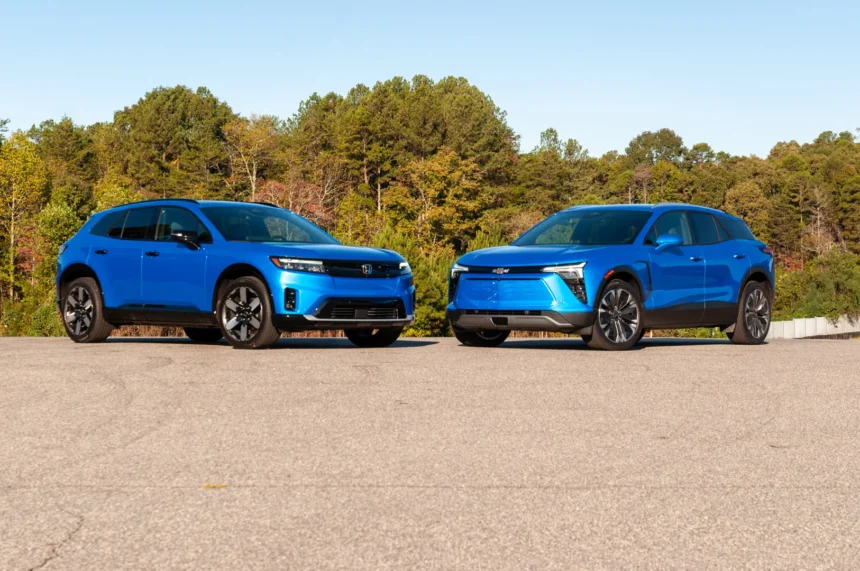Driving experience
- The Honda Prologue feels softer and more comfortable
- The Blazer EV has quicker acceleration and a sportier feel
Behind the wheel, the Honda Prologue feels the way it looks—calm, composed, and a little soft. The Prologue’s ride quality is smoother and more compliant, absorbing bumps and imperfections in the road with ease. The steering is light and responsive, making it easy to maneuver in tight spaces. Acceleration is adequate, but not as quick as the Blazer EV.
On the other hand, the Chevrolet Blazer EV is a more spirited drive. Its acceleration is quick and punchy, propelling the crossover forward with ease. The steering is more direct and weighted, giving a sportier feel to the driving experience. The Blazer EV handles corners with confidence and feels more planted on the road.
Overall, the choice between the Honda Prologue and Chevrolet Blazer EV comes down to personal preference. If you prefer a more comfortable and relaxed ride, the Prologue is the better option. However, if you enjoy a sportier driving experience with quicker acceleration, the Blazer EV is the way to go.
Both electric crossovers offer unique styling, impressive performance, and advanced technology features. Whether you choose the Honda Prologue or Chevrolet Blazer EV, you’re sure to enjoy the benefits of electric driving in a spacious and stylish package.
The comparison between the Honda Prologue and Chevy Blazer EV reveals some interesting differences that may sway potential buyers. One notable misstep for both models is the inconvenient placement of the drive mode, auto hold, and lane keep buttons hidden in a panel by the left knee, making it hard to see while driving.
When it comes to performance, both models offer dual-motor all-wheel-drive configurations with 288 hp and 333 lb-ft of torque. However, the Blazer EV can also be had in front-wheel-drive, all-wheel-drive, or rear-wheel-drive configurations, with the option for a more performance-minded model with a larger battery pack and more power. In terms of handling and steering, the Prologue offers greater stability and balance, while the Blazer EV has a tighter steering feel but a flabbier suspension.
Moving on to size and cargo capacity, both models offer generous passenger and cargo space with a long wheelbase. The Prologue has slightly less cargo space but a more open and roomy cabin, while the Blazer EV is marginally roomier but may have reduced rear headroom with the panoramic sunroof.
In terms of price and trims, the Prologue offers a more straightforward lineup with fewer drivetrain configurations. The base Prologue EX is priced at $49,000 and includes features like a configurable gauge cluster and touchscreen, wireless Apple CarPlay, and Android Auto compatibility. The Blazer EV, on the other hand, has more options and features but may be more confusing for buyers to navigate.
Overall, the Honda Prologue comes out ahead in terms of performance, handling, and simplicity in pricing and features. However, the Chevy Blazer EV offers more choice and may appeal to buyers looking for a wider range of options. Ultimately, the decision between the two models will come down to individual preferences and priorities. The 2025 Chevy Blazer EV is making waves in the electric vehicle market, offering a base model LT with all-wheel drive for $49,000. However, for those who prefer a single-motor front-wheel-drive option, Chevy promises that it will be available “soon.” The LT model comes equipped with a 17.7-inch touchscreen featuring Google Built-in, an 11.0-inch digital instrument cluster, synthetic leather upholstery, adaptive cruise control, and 19-inch alloy wheels. While the LT may lack options packages found in the higher trims, such as the RS, it still offers plenty of features for the price.
Moving up to the RS trim, priced at $54,300 for all-wheel drive, brings additional luxury and performance enhancements. This model includes a wireless smartphone charger, heated and cooled front seats, a power-adjustable steering wheel, a power tailgate, and more options for customization. The RS with rear-wheel drive and a larger 102-kwh battery tops the lineup at $57,000, catering to those seeking a more performance-oriented driving experience.
One notable drawback of the Blazer EV is the absence of Apple CarPlay, which may be a deal-breaker for some consumers. Despite this, the Blazer EV goes head-to-head with the Honda Prologue in terms of range and charge times. The Prologue boasts impressive range options, with the Prologue EX FWD offering a 296-mile range and the AWD Touring model at 281 miles. In comparison, the Blazer EV AWD has a 283-mile range, while the RS RWD model leads the pack with a 324-mile range.
Both the Blazer EV and Prologue can DC fast-charge at a peak rate of 150 kw, with similar charging times and capabilities. The Blazer EV RS RWD can charge at up to 190 kw, adding 78 miles in just 10 minutes. While Chevy charges extra for a charge cord, Honda includes it as a standard feature in the Prologue.
In terms of overall performance and efficiency, the Honda Prologue edges out the Blazer EV in terms of efficiency ratings. However, both models offer similar capabilities and are well-matched in terms of range and charging capabilities.
Ultimately, the choice between the Chevy Blazer EV and the Honda Prologue comes down to personal preference. Both models offer a solid electric vehicle option, with the Blazer EV leaning towards a more edgy and busy design, while the Prologue opts for a calmer and smoother style. With a TCC rating of 7.4 out of 10 for both models, consumers can rest assured that they are getting a quality electric vehicle regardless of their choice. Are you tired of the same old routine and looking for a change of scenery? Maybe it’s time to consider moving to a new city. Whether you’re looking to advance your career, meet new people, or just experience a different way of life, moving to a new city can be a great opportunity for personal growth and development.
One of the first things to consider when deciding to move to a new city is what you’re looking to get out of the experience. Are you looking for a bustling city with endless opportunities for networking and career advancement, or are you looking for a smaller, more close-knit community where you can put down roots and build relationships? Understanding your goals and motivations for moving can help you narrow down your options and find the perfect city for you.
Once you’ve determined what you’re looking for in a new city, it’s time to start researching potential locations. Consider factors such as cost of living, job opportunities, quality of life, and climate when evaluating different cities. You may also want to think about proximity to family and friends, as well as any hobbies or interests that are important to you. Making a list of priorities can help you focus your search and make an informed decision about where to move.
When you’ve narrowed down your list of potential cities, it’s time to start planning your move. This can be an overwhelming process, but with a bit of organization and preparation, you can make the transition as smooth as possible. Start by creating a budget to determine how much you can afford to spend on moving expenses, such as hiring a moving company, renting a truck, or shipping your belongings. You’ll also need to consider the cost of renting or buying a new home, as well as any additional expenses such as utilities, transportation, and groceries.
Once you have a budget in place, it’s time to start packing up your belongings and preparing for the move. Make a list of everything you’ll need to take with you, and start decluttering and organizing your possessions to make the packing process easier. If you’re hiring a moving company, be sure to schedule your move well in advance to ensure availability on your desired moving date. You may also want to consider purchasing moving insurance to protect your belongings in case of damage or loss during the move.
Finally, once you’ve arrived in your new city, take some time to settle in and explore your new surroundings. Get to know your neighbors, check out local restaurants and shops, and take advantage of any opportunities to meet new people and get involved in the community. Moving to a new city can be a challenging experience, but with the right preparation and a positive attitude, it can also be an exciting opportunity for growth and self-discovery. So why wait? Start planning your move to a new city today and open yourself up to a world of new possibilities. The world of technology is constantly evolving, with new advancements being made every day. One of the most exciting developments in recent years is the rise of artificial intelligence (AI). AI has the potential to revolutionize the way we live and work, with applications ranging from self-driving cars to medical diagnosis.
One area where AI is making a big impact is in the field of healthcare. AI has the ability to process and analyze vast amounts of data much faster than any human could, allowing for quicker and more accurate diagnoses. This can be especially useful in areas such as radiology, where AI can help doctors identify and analyze abnormalities in medical images.
In addition to improving diagnosis, AI is also being used to help with treatment planning. By analyzing data from thousands of patients, AI can help doctors determine the best course of treatment for a particular patient based on their individual characteristics and medical history. This personalized approach to medicine has the potential to greatly improve patient outcomes and reduce healthcare costs.
Another area where AI is making a big impact is in drug discovery. Developing new drugs is a long and expensive process, but AI has the potential to streamline this process by quickly analyzing vast amounts of data to identify potential drug candidates. This can help speed up the development of new treatments for diseases and improve the success rate of clinical trials.
AI is also being used to improve the efficiency of healthcare systems. By analyzing data on patient outcomes and treatment protocols, AI can help identify areas where improvements can be made to reduce costs and improve patient care. This can help healthcare providers better allocate resources and improve overall quality of care.
While AI has the potential to revolutionize healthcare, there are also challenges that need to be addressed. One of the biggest concerns is the ethical implications of using AI in healthcare, such as ensuring patient privacy and maintaining the trust of patients. Additionally, there are concerns about the potential for bias in AI algorithms, which could result in unequal treatment for certain groups of patients.
Overall, the rise of AI in healthcare is an exciting development with the potential to greatly improve patient care and outcomes. By harnessing the power of AI, healthcare providers can provide more personalized and efficient care to patients, leading to better outcomes and a healthier population. As AI continues to evolve, we can expect to see even more advancements in the field of healthcare that will transform the way we approach diagnosis, treatment, and prevention of diseases. The Benefits of Exercising Outdoors
There is no denying the numerous benefits of regular exercise for both physical and mental health. But did you know that exercising outdoors can provide even more benefits than working out in a gym or at home? In this article, we will explore the many advantages of taking your workout routine outside.
One of the main benefits of exercising outdoors is the exposure to natural light and fresh air. Spending time in nature has been proven to reduce stress, anxiety, and depression, and can help improve mood and overall mental well-being. The natural sunlight also helps boost vitamin D levels, which is essential for bone health and immune function.
Another advantage of outdoor exercise is the variety of terrain and environments you can explore. Whether you prefer running on a trail through the woods, cycling along a scenic route, or doing yoga in a peaceful park, there are endless possibilities for outdoor workouts. This variety can help prevent boredom and keep you motivated to stay active.
Exercising outdoors also allows you to connect with nature and appreciate the beauty of the world around you. Studies have shown that spending time in nature can improve focus, creativity, and cognitive function. So next time you feel stuck in a workout rut, consider taking your exercise routine outside for a change of scenery.
Additionally, outdoor workouts can be more challenging and engaging than indoor workouts. Running or cycling against the wind, navigating uneven terrain, and dealing with changing weather conditions can all add an extra element of difficulty to your workout, helping to improve endurance, strength, and coordination.
Finally, exercising outdoors can be a social activity that allows you to connect with others and build a sense of community. Whether you join a group fitness class in the park, go for a hike with friends, or play a game of basketball at the local court, outdoor exercise can be a fun and social way to stay active.
In conclusion, there are numerous benefits to exercising outdoors, from improved mental health and well-being to increased physical fitness and social connections. So next time you lace up your sneakers or grab your yoga mat, consider taking your workout routine outside and reap the many rewards of exercising in nature. It seems that Artificial Intelligence (AI) has been making waves in various industries, with its potential to revolutionize the way we live and work. From self-driving cars to virtual assistants, AI is changing the way we interact with technology. But one area where AI is truly making a difference is in healthcare.
AI is being used in healthcare to improve patient outcomes, streamline processes, and reduce costs. One of the most promising applications of AI in healthcare is in the field of medical imaging. Radiologists are using AI to assist in the interpretation of medical images, such as X-rays, MRIs, and CT scans. These AI-powered tools can help identify abnormalities more quickly and accurately than traditional methods, leading to better diagnoses and treatment plans.
In addition to medical imaging, AI is also being used to predict patient outcomes and personalize treatment plans. By analyzing vast amounts of patient data, AI can help healthcare providers identify trends and patterns that can inform decision-making. For example, AI can help predict which patients are at risk of developing certain conditions, allowing for early intervention and preventative measures.
AI is also being used to improve operational efficiency in healthcare systems. By automating routine tasks, such as scheduling appointments and managing medical records, AI can free up healthcare providers to focus on more complex and critical tasks. This not only improves patient care but also reduces administrative costs and improves overall efficiency.
Despite the many benefits of AI in healthcare, there are also challenges that need to be addressed. One of the main concerns is the potential for bias in AI algorithms. If AI is trained on biased data, it can perpetuate existing inequalities in healthcare. It is crucial for developers to ensure that AI algorithms are fair and unbiased to avoid exacerbating disparities in healthcare outcomes.
Another challenge is the need for clear regulations and guidelines around the use of AI in healthcare. As AI becomes more integrated into healthcare systems, it is important to establish standards for data privacy, security, and ethical use of AI. Healthcare providers must also be trained on how to use AI tools effectively and interpret the results accurately.
Overall, AI has the potential to transform healthcare in profound ways. By leveraging the power of AI, healthcare providers can improve patient outcomes, reduce costs, and streamline processes. However, it is crucial to address the challenges and concerns surrounding the use of AI in healthcare to ensure that it is used responsibly and ethically. With the right approach, AI has the potential to revolutionize healthcare and improve the lives of patients around the world.







